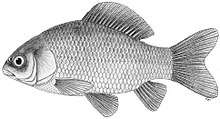붕어
Korean

붕어
Etymology
First recorded in the Hunmong Jahoe, 1527, as 부어 (鮒魚). Includes the hanja suffix 어 (魚, eo, “fish”). Note that 魚 had the consonant /ŋ/ as an initial, and 붕어 is rather 부 (鮒) + ㅇ어 (魚).
Pronunciation
- IPA(key)[ˈpuːŋʌ̹]
- Phonetic Hangul[붕:어]
|
Derived terms
- 붕어빵 (bung-eoppang, “fish-shaped bean-filled pastry”)
This article is issued from
Wiktionary.
The text is licensed under Creative
Commons - Attribution - Sharealike.
Additional terms may apply for the media files.